Becoming Bok: From Decommissioned School to South Philly’s Center of Creative Cool

The Bok Building in South Philly. Photography by Steve Boyle
I’m standing in a 1,200-square-foot room divided by a pink-wallpapered partition. On one side are neat shelves of scented candles and potted succulents, a black velvet couch, and a neon pink sign that reads, “All you need is brows.” On the other side, three women are fully reclined, having semi-permanent eyebrows painstakingly painted on their faces. The plush space is home to Forever Valentine Beauty, owned by Kelly Haney. If I’d magically apparated here, I would assume I was in an edgy salon in Fishtown, or Brooklyn. As it is, I took a service elevator up five floors and walked down a somewhat drab terrazzo hallway, passing intermittent rows of vintage metal lockers.
I’m in the Bok Building, in the heart of South Philly. But it’s impossible to tell that inside Forever Valentine, where a spotless white drywall shell hides a chalkboard that’s been bolted to the wall probably since the Roosevelt era, back when the building opened as a vocational school. Historic regulations prohibit its removal, so Haney got creative, adding a bold black mural to the blank canvas. She made the space her own.
“Kelly started off sharing a space with her husband, who runs Forever Valentine Tattoo, down the hallway; then she expanded to this room and then across the hallway,” explains Lindsey Scannapieco, managing partner of Scout, the development firm behind Bok, as she leads me on a tour. Haney’s business has grown its footprint in the building since she started in 2018, from 500 square feet to 2,000. “She has a waiting list about a year long,” Scannapieco says as we breeze past the artist’s second space. “You can’t even get your eyebrows touched by Kelly.”
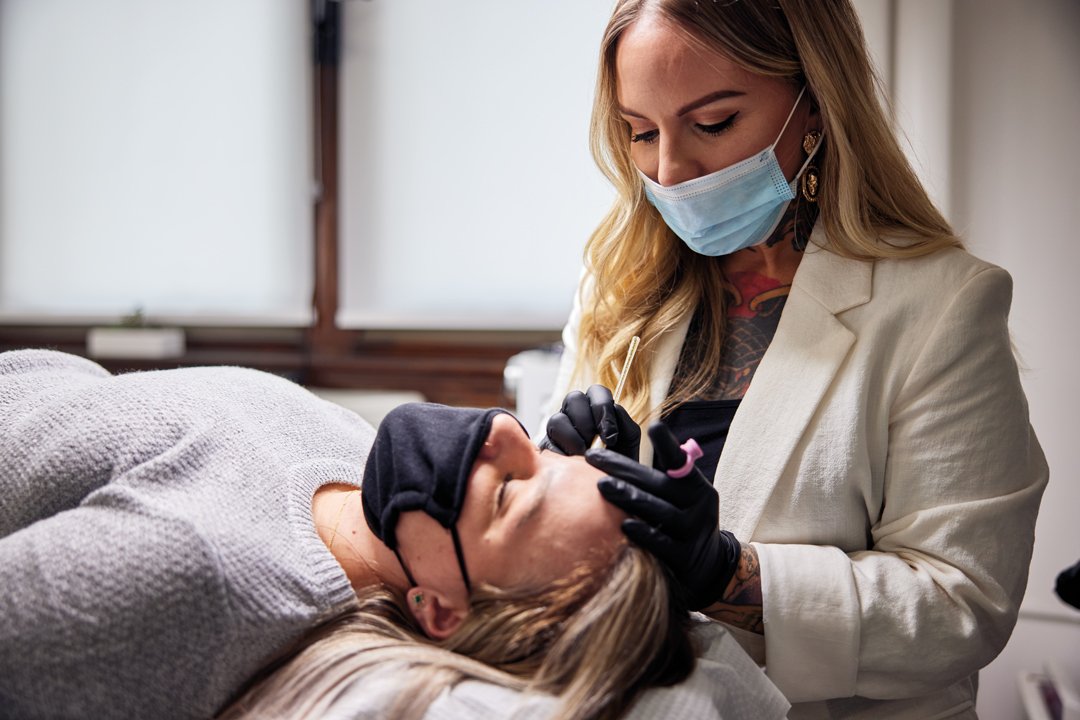
Owner of Forever Valentine Beauty Kelly Haney applies semi-permanent eyebrow tattoos on a client — process called microblading. Haney’s is one of the nearly 50 percent of businesses operating in the Bok Building that are run by women. Photograph by Steve Boyle

Clockwise from top left: Rachel Snack of Weaver House, Rhonda Saltzman and Mercedes Brooks of Second Daughter Baking Co., Kelly Haney of Forever Valentine Beauty, Jeff Rubio and Elliot Reynolds of Centerpeak, Emily Riddell of Machine Shop Boulangerie, and Keesean Moore of Moore Vintage Archive. Photography by Steve Boyle

On the ground floor, Adam Gery of Two Persons slings coffee and French and vegan pastries from local bakeries. “Coming to work at Bok, even when things were dark and uncertain, has been a saving grace thanks to the friends and relationships we’ve made here,” says Gery. “They’ve made it feel bearable at times when we needed support the most.” Photograph by Steve Boyle
Haney is just one of more than 220 tenants operating in Bok, the hulking stone-and-brick building erected in 1936 as part of FDR’s Public Works Administration. Once populated by thousands of in-training car mechanics, welders and hairdressers, the 340,000-square-foot space houses a new class of hands-on makers: Tucked into former classrooms and workshops are weavers, ceramicists, florists, filmmakers, screen printers, painters and photographers. There’s a pair of sisters baking the city’s best brownies, the country’s foremost clarinet repairman, and a Francophile who combs Parisian flea markets to stock his shop with wearable treasures. It feels like the Etsy homepage come to life. “The building is a shell for amazing things to happen,” Scannapieco tells me. It’s been true in the seven years since Scout took over the building, and it feels even more so now. In the nearly two years since we’ve been living with a global pandemic — a time of widespread uncertainty and general existential dread — the building has thrived and become more relevant than ever.
On our tour, Scannapieco, 35, guides me around with the unflappable ease of someone who not only knows the tenants, but knows all the secrets of this old building. Raised in Fairmount, she went to college in California and eventually moved to Britain to study city design and social science at the London School of Economics. She founded Scout in 2011 as an urban design firm focusing on hard-to-use spaces. Scout’s first project was a buzzy success in its three-week run — Films on Fridges involved setting up an outdoor cinema across from London’s 2012 Olympic Stadium.

Scout founder and managing partner Lindsey Scannapieco inside her office at the Bok Building. Photograph by Steve Boyle
In 2014, Scannapieco came across the Bok Building for sale on a website auctioning former schools. With financing from a combination of construction loans, new markets tax credits and historic tax credits, she and her team won the bidding, coming in at the $1.75 million asking price. Tapping into Scout’s expertise, her team intended to unlock Bok’s hard-to-use space. Instead of showing fleeting movies, though, they transformed the seemingly immutable monolith into a vertical city of makers.
Back when COVID first emerged in the spring of 2020, Scannapieco joined the rest of the world in panicking. “I have to say, I was freaking out last April,” she says. “I was like, the ship’s going down.” But instead of sinking like a city-block-size stone, Bok actually flourished. Scout was able to offer grants to 98 percent of tenants who asked for help, and there was turnover of less than five percent of square footage in the building during the first 17 months of the pandemic. “We actually brought a lot of new tenants in,” she says.
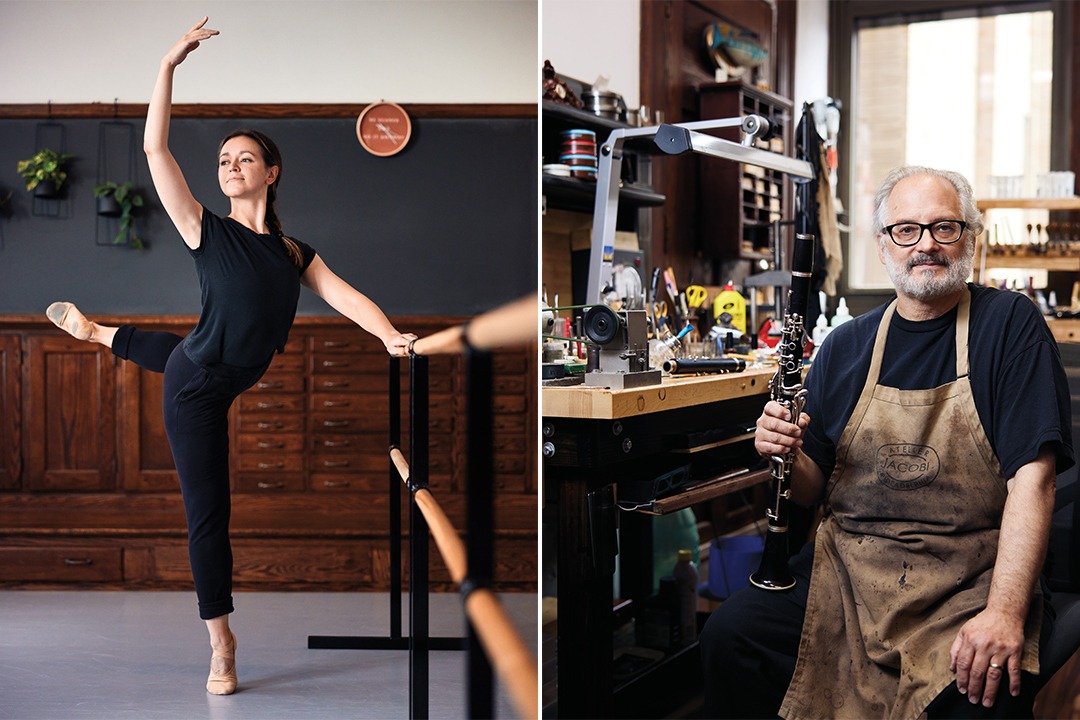
Left: Dancer Amy Novinski loves her new studio, where she teaches ballet to students of all skill levels. The chalkboard — a vestige of the room’s days as a history classroom — is used for writing out ballet vocabulary. Right: From a 200-square-foot space, Mark Jacobi runs Atelier Jacobi, repairing clarinets from all over the country. The best part of working at Bok, he says, “is the mixture of the old-world craftsmen, artists and jewelers and the technologies of the future.” Photography by Steve Boyle

Textile artist Rachel Snack runs Weaver House, where she sells yarn and tools and recently began teaching classes again. Photograph by Steve Boyle
Bok’s resilience illustrates a wider trend: When people lost jobs and were forced to stop and reflect on their lives, careers and goals, many decided they wanted to be more self-reliant. Some just longed to pivot to something more hands-on, prioritizing creativity for mental health.
For others, the impetus to find space when it became clear that offices weren’t opening back up anytime soon was as simple as “I need to get away from my dog, my spouse, my child or my fridge,” says Scannapieco. Whatever the reasons, Scout made it straightforward for new tenants to take the leap. Traditional commercial real estate options often come with long-term leases (and in some cases, fewer options for growing or shrinking space); the Bok’s barrier to entry is much lower. On offer here: wider flexibility for evolving businesses, including shorter leases and, as Forever Valentine’s Haney discovered, the ability to expand beyond one’s original vision.
“We were way more nimble in being able to respond to people’s needs,” says Scannapieco. And, she points out, would-be tenants were eager to bust out of their own homes and craving community space.
Bok’s vitality illustrates a wider trend: When people lost jobs and were forced to stop and reflect, many decided they wanted to be more self-reliant. Some just longed to pivot to something more hands-on.
One of those tenants was Amy Novinski, who runs an eponymous ballet studio. The dancer was teaching in-person classes before COVID prompted her to move online. But even with students Zooming in — from elsewhere in Philly as well as California, Canada and England — Novinski felt she needed a bigger space, “to accommodate whatever transitions were about to happen in the world,” she explains. Plus, she and her cat were battling for room in her nearby apartment. Walking into her Bok studio, with its wall of oversize windows and lofty ceiling, felt like taking a deep breath. “Just even going four steps in a direction was bliss,” she says. She wasn’t alone. Students who came for in-person lessons had been doing virtual classes for so long that adjusting to the extra space was a challenge; they had to recalibrate their centers of gravity before fully unfurling.
When Scout took over Bok in 2014, instead of leveling the building to make way for luxury condos or giving it a sleek new makeover, the team did a light renovation. The thought process was that the less money they invested in transforming the building into “sexy creative spaces” — something Scannapieco says had been the current trend — the less they would have to charge for rent. That meant still lower barriers to entry for nascent business owners and first-time renters, who make up roughly 44 percent of Bok tenants. “Just the process of signing a lease is actually a really big jump,” Scannapieco says. The lack of niceties like common areas with marble-topped tables and bespoke pillows also means the Bok Building fills a hole Scannapieco sees in the market for what she calls “dirty space.”
“It’s the ability for somebody to make a mess,” she says. “And that could be physically, like planting succulents, or working with watercolors or ceramics or weaving.” It’s true that potting up snake plants — or spraying neon yellow dye on cropped crewneck sweatshirts, as Philadelphia Printworks is doing on the fifth floor and in the basement — would most certainly be frowned on if done at a WeWork desk.
The less-shiny spaces, too, drive the stakes a little lower for tenants, allowing them the freedom to see what works for their businesses or projects or workflows. They mean that making a pivot, whether tweaking a business model or growing out of an original leased space, is okay.
“So we’re accepting the building in its condition,” Scannapieco explains. “It’s all about finding people who can find the usefulness in that.” This is where the Scout team, including leasing director Liz Maillie, really shines. Scannapieco says she’s not a matchmaker; she doesn’t connect the tenants or do anything specific to encourage collaborations within the building (of which there are many).
Renting a space in Bok allows for separation between home and work. “It’s really important for people’s creative processes and for their mental health,” says Scannapieco.
But the majority-female Scout team plays a remarkable game of Tetris, dropping tenants like puzzle pieces into the massive structure so they seem to fit seamlessly. “We really try to be conscious of where we put people by sounds and smells,” explains Scannapieco. The spray-painting screen printers, for example, are situated near beauty brand Franklin & Whitman, which also emits scents in the form of fragrant essential oils that are added to products like serums and body scrubs; this modifies the scent of the paint. The team also takes into account factors like tenant needs. Domino Yarra, who runs DNA Floral, uses a sink while arranging flowers, so she’s in a former mechanic’s shop with a long white ceramic one attached to the wall. Novinski needed high ceilings and unobstructed floor space in which students could twirl, and contemporary realist art school Studio Incamminati, which signed a lease in March of 2020, required plenty of good light and outdoor space for live-model painting classes.
“Ultimately, we’re giving people space, but they’re able to kind of make it what they want. With some caveats,” Scannapieco says. And some tenants’ needs go beyond choosing the environments in which their businesses can best flourish. The building is home to more than 30 couples who work either together or separately. Some request spaces on the same floor … and some do not.
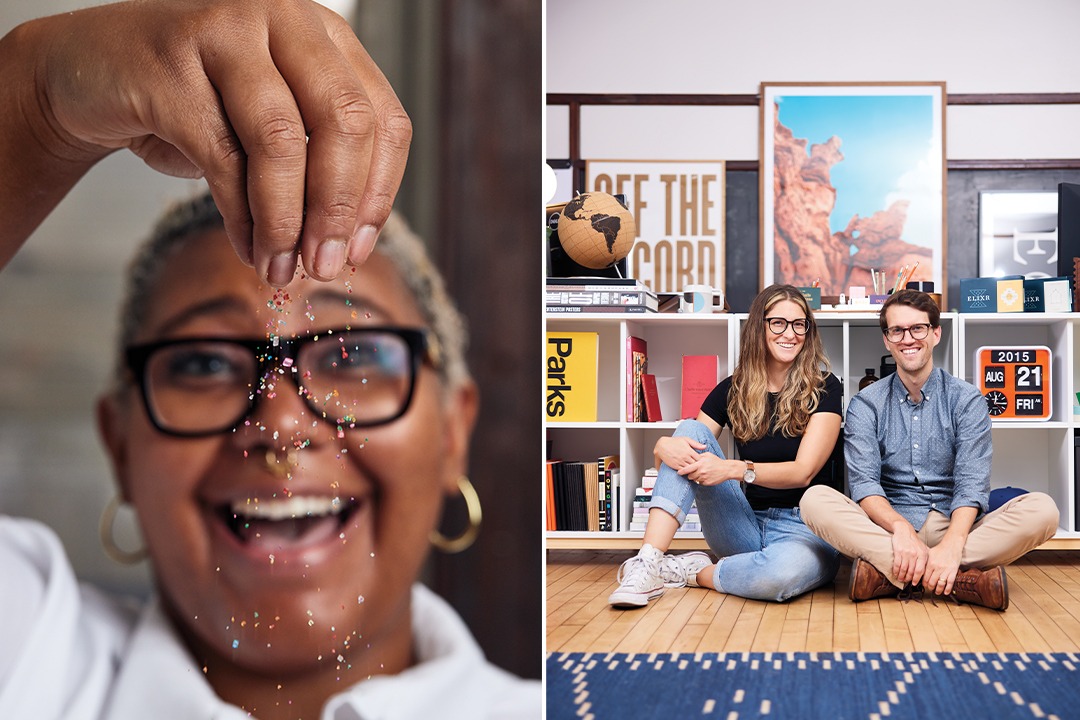
Left: Rhonda Saltzman started Second Daughter Baking Co. with her sister, Mercedes Brooks. Working out of Bok during the pandemic “has been the key to our success,” says Saltzman. “It provided a space for us to thrive. We were able to stop baking out of our mom’s kitchen.” Right: Chara and Mike Smith, the couple behind design and copywriting studio Smith & Diction, have worked on Philly-based Elixr Coffee Roasters’ packaging and a rebrand of fellow Bok tenant Sabbatical Beauty. “Working in an old classroom immediately puts you in a different kind of headspace,” says Mike. “At Bok, you feel like you’re getting away with something — like you’re doing an after-school project, but it’s actually your career.” Photography by Steve Boyle

“As weird as it may seem, the pandemic was kind of good for artists,” says Dan Thompson, Studio Incaminnati dean of fine arts. “It was a chance to look inward.” The contemporary realist art school takes up the seventh floor of Bok. Photograph by Steve Boyle
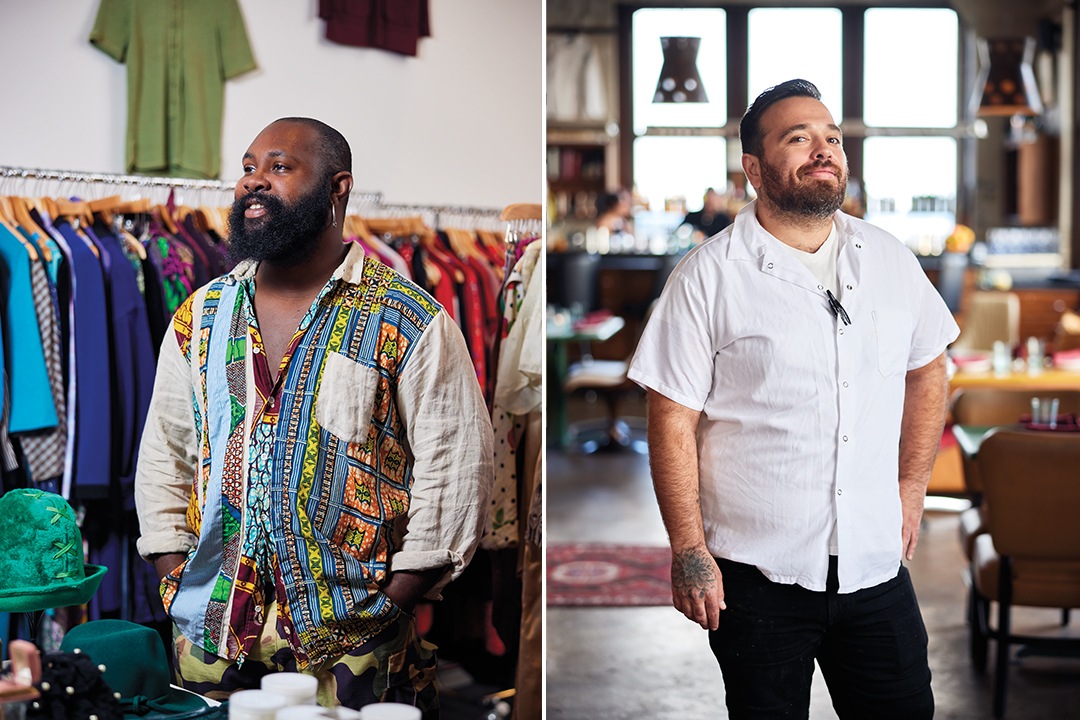
Left: “I’m a double Aries, so I get bored very easily,” says Keesean Moore, owner of Moore Vintage. “But here, I just feel invigorated.” Right: Michael Vincent Ferrari was the chef at Res Ipsa before it closed during the pandemic. He took over at Irwin’s last spring with a menu of handmade pasta and small plates. Photography by Steve Boyle
Spaces run the gamut from an entire floor (Studio Incamminati) to a jewelry designer with 75 square feet and the clarinet repairman, Mark Jacobi, who runs Atelier Jacobi out of 200 square feet: “We call it one of our specialties here,” says Scannapieco, “which is a closet with a window.” That sells the units a bit short — the spaces I saw while touring the behemoth were filled with natural light, and many had charming features like vintage wooden built-ins.
It’s true that 70 percent of the building’s roughly 200 units are under 1,000 square feet. But whether a space is customer-facing (Valentine, where clients come for beautifying tattoos, or Moore Vintage, where Keesean Moore’s impeccable taste in vintage threads occupies two long racks that bookend his sophisticated shop) or not (Centerpeak, where ceramicists and designers Jeff Rubio and Elliot Reynolds create sculptural housewares in a gallery-esque workspace), each feels as creative, curated and utterly cool as its occupant.

Spaghetti alle vongole (right) and octopus with salsa verde at Irwin’s. Photography by Steve Boyle
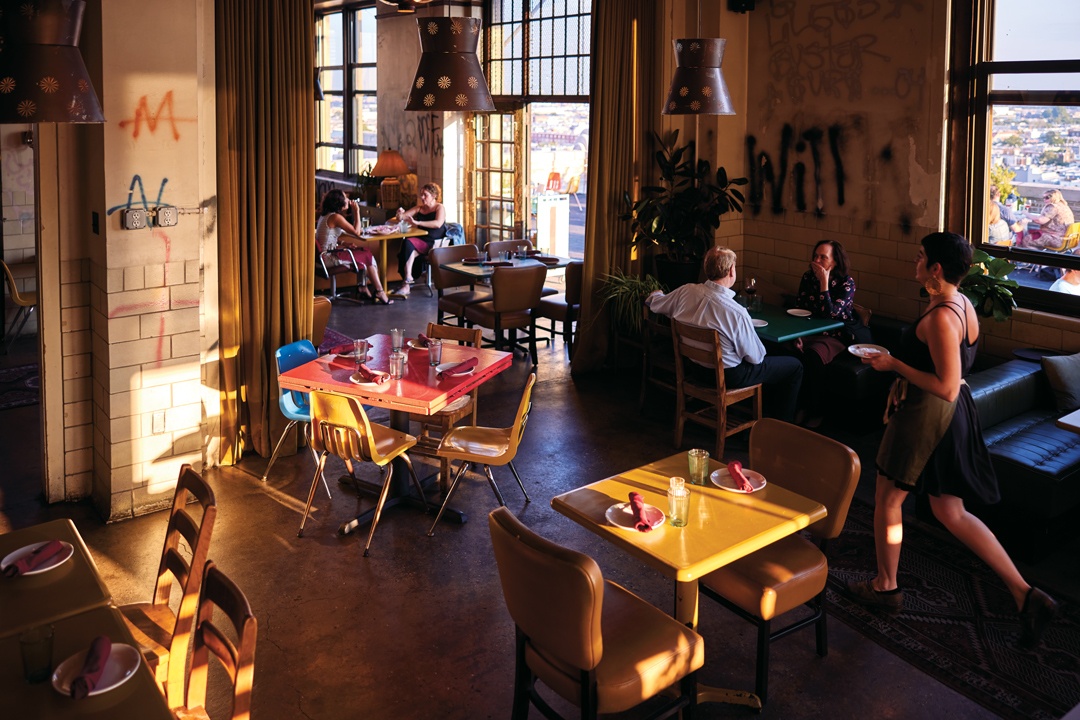
Guests take the elevator to the eighth floor for Michael Vincent Ferrari’s Sicilian-inspired dishes at Irwin’s and for the sweeping South Philly view. Photograph by Steve Boyle
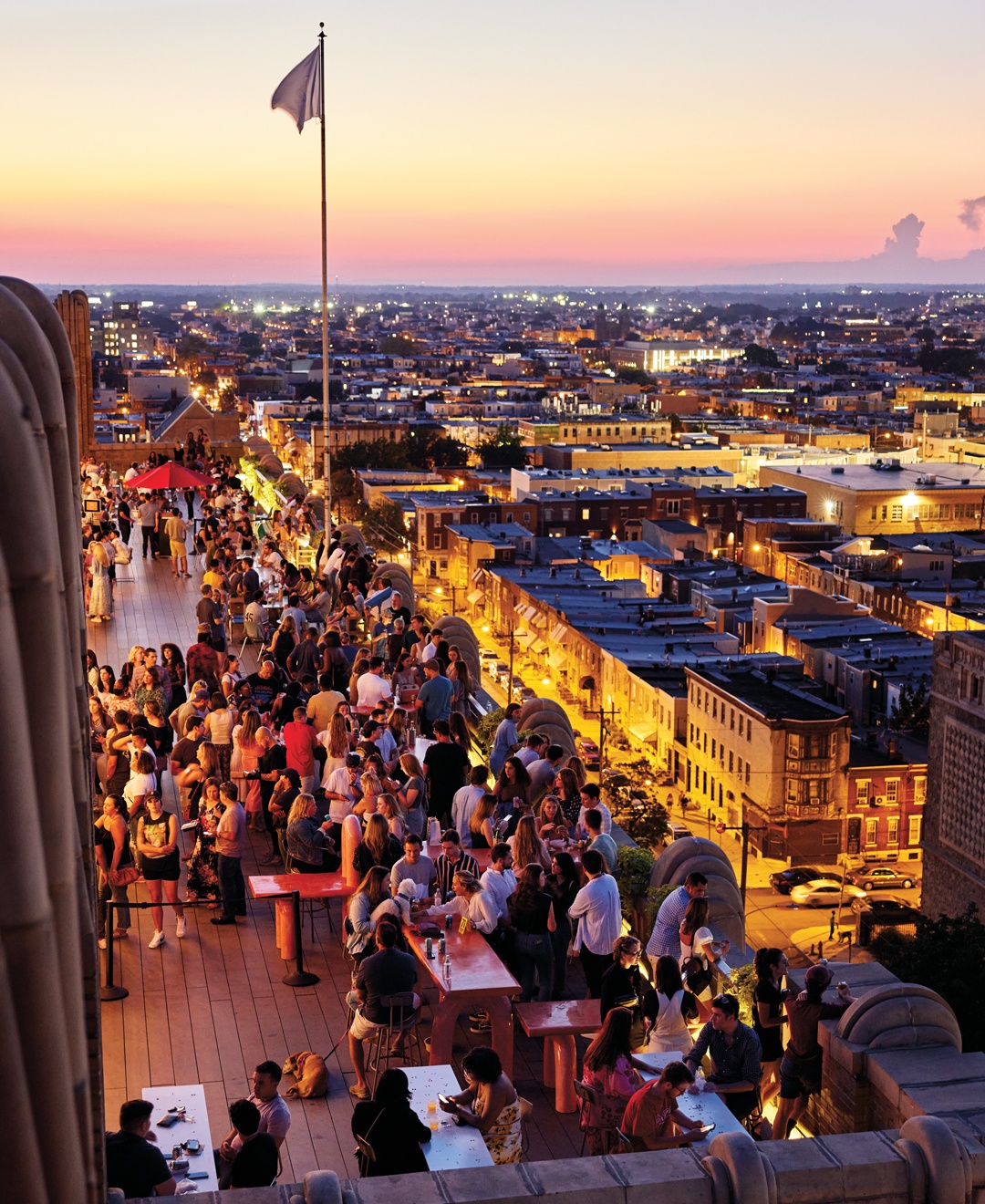
“The view brings people through the door, but the energy here is what brings them back,” says Bok Bar events manager Jackie Rush. Photograph by Steve Boyle
Renting a space in Bok — starting at $500 a month — allows the separation between home and work that so many people have yearned for in the past two years. “It’s really important for people’s creative processes and for their mental health,” says Scannapieco. “And I think that translates to their economic success.” To wit: Twenty-five percent of tenants have doubled in size in their time renting at Bok.
“Just being able to watch somebody take something that started in their living room, then renting 500 square feet and growing it to 2,000 square feet — ” Scannapieco pauses. “We always say: We’re here to make dreams come true.”
Published as “Becoming Bok” in the November 2021 issue of Philadelphia magazine.